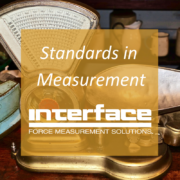The Year of High-Performance Force Measurement
 In 2024, the increasing need for precision, automation, and data-driven insights across various industries drove meaningful advancements in force measurement applications. As we move into the new year, several key trends will define the future of how load cells and high-performance sensor technologies shape our world.
In 2024, the increasing need for precision, automation, and data-driven insights across various industries drove meaningful advancements in force measurement applications. As we move into the new year, several key trends will define the future of how load cells and high-performance sensor technologies shape our world.
2025 is where high performance and accuracy take center stage. Industries are demanding more than just basic readings. Precise, reliable measurement data drives innovation and efficiency. The increasing complexity of product design, stringent testing requirements, and the growing need for real-time performance monitoring are fueling requirements for precision data. Let’s explore the top five 2025 trends in high-performance force measurement.
MINIATURIZATION AND WIRELESS CONNECTIVITY
Miniature sensors and wireless devices are not new trends, but they continue to evolve. The demand for smaller, lighter, and more portable force measurement devices is skyrocketing. This trend is driven by the need for integration into compact spaces and applications where traditional sensors are impractical. Wireless connectivity is also becoming increasingly important, allowing for remote monitoring and data collection while in operation. Engineers are trending toward adapting sensors to meet the demands of IoT, diverse connectivity, and high-accuracy measurement in designs that are much smaller in scale.
Mini and Wireless Trends to Watch in 2025
- Developing projects using miniature load cells within a range of small and large capacities, like our load button load cells and the SuperSC, fulfills the accuracy and durability requirements in a miniaturized form factor.
- Increased adoption of wireless communication protocols like Bluetooth 5.0 and Wi-Fi 6 for seamless data transfer requires sensors that can ‘plug and play’ in these environments. Review: Decoding Sensor and Instrumentation Communication Protocols Webinar Recap
- Integration of force measurement capabilities into wearable devices and IoT (Internet of Things) systems for continuous performance monitoring and adjustments to customer user requirements is pushing for small and wireless capabilities in their measurement sensor tech.
SMART SENSORS AND ADVANCED ANALYTICS
Force sensors are increasingly used for “smarter” purposes. The immediacy of data processing and results monitoring is increasing uses like predictive maintenance capabilities. The data generated by these sensors helps to optimize processes, improve product quality, spur inventions, and prevent equipment failures.
Innovative Applications Using Sensors and Data Trends to Watch in 2025
- Increasing use of machine learning algorithms helps to analyze force data and identify patterns and anomalies in research, development, testing, and product design.
- Using cloud-based platforms for measurement data storage, visualization, and collaborative analysis through wireless, IO-Link, and Bluetooth sensor and instrumentation connections matters in 2025. Sensors must be adaptable to this type of use. Check out our Wireless and Bluetooth® Selection Guide.
- Integration of force measurement sensors into comprehensive systems provides a holistic view of performance, whether it pertains to robotics in the workplace or devices that enable instant decision-making for performance.
CONFIDENCE IN TRACEABILITY AND STANDARDS
Sensor traceability is paramount as industries strive for greater precision and efficiency in product design, testing, manufacturing, and performance monitoring. Expect a renewed focus on standards, particularly in regulated industries that demand higher quality standards and greater transparency.
Traceability and Standards Trends to Watch in 2025
- End-to-end traceability, achieved by meticulously documenting the entire calibration process, from the primary standards to the final sensor calibration, provides confidence to sensor technology users. It ensures that every measurement is traceable to a known reference, providing certainty in the data’s accuracy and reliability. Interface’s use of our Gold Standard Calibration Grade Load Cells and new Gold Standard GoldNXT Software for calibration and traceability supports this trend.
- Accreditation and standards compliance demands greater adherence to international standards like ISO/IEC 17025 for calibration laboratories. This accreditation ensures that laboratories meet the highest technical competence and quality management levels, guaranteeing accurate and reliable force measurements. With components and products sourced worldwide, providing consistent measurement standards across the supply chain is crucial for quality control.
- Trustworthy data based on a sensor’s accuracy and reliability will not wane in 2025. High-performance force sensors will be critical in pushing the boundaries of innovation in fields. Ensuring precise force control in surgical robots, implantable devices, and drug delivery systems for improved patient safety and outcomes requires exception measurement solutions. Monitoring critical forces in aircraft structures, engines, and control systems for enhanced performance, safety, and reliability needs best-in-class load cells and torque transducers. As data-driven decision-making becomes more prevalent, confidence in the accuracy and reliability of force measurement data is paramount.
EMERGING APPLICATIONS
Force measurement is crucial in developing and deploying emerging robotics, automation, additive manufacturing, and 4D bioprinting technologies. It detects anomalies and predicts potential failures in machinery and equipment, enabling proactive maintenance. These applications require precise control of forces and torques to ensure accurate manipulation, assembly, and fabrication.
Emerging Application Trends to Watch in 2025
- Integrating force sensors into collaborative robots (cobots) is fundamental for safe and efficient human-robot interaction. AI, based on data from load cells, is driving faster robotics development. Precision impacts performance today and in future robotic development.
- The use of force feedback in virtual and augmented reality applications for realistic simulations and training is growing. Flight simulators, space habitat designs, eSport equipment and venues, and 3D modeling are adopting continuous force feedback through integrated sensors to make the experience authentic.
- Sensors for subsea and challenging environments are becoming more common. Forces are measured in fish farming cages, mooring lines, and other submerged structures to ensure safe and efficient operations, even in harsh conditions. Data on ocean currents, wave forces, and underwater seismic activity improve our understanding of the marine environment. Read Hazardous Environment Solutions from Interface.
GROWING IMPORTANCE OF SUSTAINABILITY
The increasing focus on sustainability is also impacting the force measurement industry. Manufacturers require sensors to help them consume less energy and use eco-friendly materials. Force measurement data helps optimize processes and reduce waste, contributing to a more sustainable future.
Sensors in Sustainability Trends to Watch in 2025
- Splash zones and wireless force sensors that operate without external cables or power sources are becoming more common. Remotely operating equipment incorporating a highly accurate miniature sensor is ideal for windmills, at-sea solar panels, and near-shore lifting equipment.
- Recycled and recyclable materials are growing in use and demand. As waste and water management become ubiquitous to environmental sustainability, using sensors for equipment such as machines, gates, belts, and other equipment fosters faster adoption.
- Force measurement technology is essential for monitoring and improving energy efficiency. The increasing demand for clean energy sources is driving the expansion of offshore wind and marine energy projects. For example, force sensors in wind turbines optimize blade pitch to maximize energy capture, contributing to a more sustainable energy future.
Integrating high-performance force measurement sensors into new products, retrofitting existing equipment, and building comprehensive systems to provide a holistic view of performance are big influences on the trends in 2025 and beyond. Whether the use pertains to robotics in the workplace or devices that enable instant decision-making, sensor technologies are at the forefront of these advancements.
Interface is poised to support the demands, trends, continued growth, and innovation. Our customers can leverage our tools and devices to improve their products, processes, and overall competitiveness by staying abreast of these key trends and advancements. Contact us to explore how we can help you seize on the trends influencing your testing projects and new developments.







